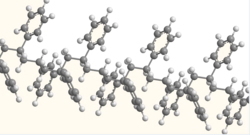Expanded polystyrene foam
 |
|
 |
|
| Names | |
|---|---|
|
IUPAC name
Poly(1-phenylethene)
|
|
| Other names
Thermocol
|
|
| Identifiers | |
| Abbreviations | PS |
| ChemSpider |
|
| ECHA InfoCard | 100.105.519 |
| Properties | |
| (C8H8)n | |
| Density | 0.96–1.04 g/cm3 |
| Melting point | ~ 240 °C (464 °F; 513 K) For Isotactic Polystryene |
| insoluble | |
| Solubility | very soluble in acetone |
| Thermal conductivity | 0.033 W/(m·K) (foam, ρ 0.05 g/cm3) |
|
Refractive index (nD)
|
1.6; dielectric constant 2.6 (1 kHz – 1 GHz) |
| Related compounds | |
|
Related compounds
|
Styrene (monomer) |
|
Except where otherwise noted, data are given for materials in their standard state (at 25 °C [77 °F], 100 kPa).
|
|
| Infobox references | |
Polystyrene (PS) /ˌpɒliˈstaɪriːn/ is a synthetic aromatic polymer made from the monomer styrene. Polystyrene can be solid or foamed. General-purpose polystyrene is clear, hard, and rather brittle. It is an inexpensive resin per unit weight. It is a rather poor barrier to oxygen and water vapour and has a relatively low melting point. Polystyrene is one of the most widely used plastics, the scale of its production being several million tonnes per year. Polystyrene can be naturally transparent, but can be coloured with colourants. Uses include protective packaging (such as packing peanuts and CD and DVD cases), containers (such as "clamshells"), lids, bottles, trays, tumblers, disposable cutlery. and in the making of models.
As a thermoplastic polymer, polystyrene is in a solid (glassy) state at room temperature but flows if heated above about 100 °C, its glass transition temperature. It becomes rigid again when cooled. This temperature behaviour is exploited for extrusion (as in Styrofoam) and also for molding and vacuum forming, since it can be cast into molds with fine detail.
Polystyrene is slow to biodegrade and is therefore a focus of controversy among environmentalists. It is increasingly abundant as a form of litter in the outdoor environment, particularly along shores and waterways, especially in its foam form, and also in increasing quantities in the Pacific Ocean.
...
Wikipedia
